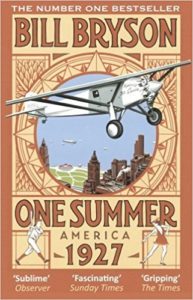The summer of 1927, to be precise. The summer that Charles Lindbergh flew across the Atlantic, that Babe Ruth returned to form and led the New York Yankees to dominate baseball, a summer that Calvin Coolidge didn’t have much to say (not that that was unique to 1927), the summer that Sacco and Vanzetti were executed, and the summer of the invention of a key part of television technology. Bill Bryson uses each of these events as the main element of a chapter covering one month of the summer of 1927. Together, they are intended to form a portrait of America at a particular time in its history, to capture the spirit of the 1920s at their dizzying height, before the stock market crash and ensuing Great Depression ushered in a completely different era.
One Summer is typical Bryson in that it is conversational, congenial, chock full of facts, and completely conventional. I used to be a great fan of Bryson, and I can still see the appeal, but now he feels incomplete to me, especially when he is writing about history rather than, say, personal travel experiences. (I would return to A Walk in the Woods; it’s very unlikely that I will re-read One Summer.) I liked and still like his wry tone, his drollery, though I worry sometimes about the details of his research. But the problem is right there in the structure of the book: the five events that Bryson chooses as the supports for his book are all about men, and white men at that (even allowing for whether contemporaries would have considered Sacco and Vanzetti white, which obviously many did not). Bryson never makes more than an implicit argument about why he chose these five, leaving the reader to wonder whether he is blinkered, whether his publisher is, or both of them worked together to overlook well more than half of America’s population. Bryson’s America of 1927 has two regions at most: the Northeast, though really the bulk of what he describes in the Northeast happens in and around New York City, and the Midwest. Parts of the South flood, but the region is otherwise almost entirely absent, except for a brief excursion into the absurdities of Florida real estate markets. The West provides a place for Coolidge to play cowboy and a location for Mount Rushmore. There are a few more incidents on the West Coast during aviation tours, and Bryson describes the Utah childhood of Philo T. Farnsworth, the television inventor, but the West is also conspicuous by its absence in Bryson’s view of America.
My knowledge of 1920s America is cursory at best, but even I can recall the Harlem Renaissance, the new freedoms that many women found in the Jazz Age, writers such as Edna St Vincent Millay and Dorothy Parker. Why didn’t Bryson choose any of these people or subjects as one of his main topics? He doesn’t say, any more than he says why he made the choices he did. For a book published in the second decade of the 21st century, this lack of reflection is inexcusable.
I had the book with me on a two-week bicycle tour, so I set aside my concerns about the overall tenor of the book and went ahead and read it. Bryson can drop an anecdote, he can spin a yarn, and he can tell a short tale. He tells a lot of them in One Summer, and they are almost all interesting at the time of reading. Some are genuinely nifty notions: he claims (argues would be too strong) that Lindbergh’s tour of American cities in the Spirit of St Louis spurred decision-makers to support regular air service among cities that were then linked by chaotically competing railroads and irregularly paved roads. He captures the lively state of musical theater just before talking motion pictures changed popular entertainment. “An enormous exodus was about to begin. Spencer Tracy, Clark Gable, Humphrey Bogart, Fredric March, Bette Davis, W.C. Fields, James Cagney, Claudette Colbert, Edward G. Robinson, Leslie Howard, Basil Rathbone, Claude Rains, Cary Grant, Paul Muni, Paulette Goddard and many more who could be seen in 1927 on Broadway would all shortly decamp to Hollywood.” (p. 523) He spends some exposition on Mabel Walker Willebrandt, an assistant attorney general (and the most senior woman in Warren Harding’s government) who devised the legal strategy of attacking organized crime on the basis of tax evasion.
His take on Sacco and Vanzetti is much more problematic. After laying out how thin the state’s case was, how inept the investigation, how many thumbs were placed on the scales of justice, Bryson appears to come out on the side of “Many people closely involved in the case, then and now, concluded that Sacco and Vanzetti were certainly guilty of something.” (p. 456) It’s a long, long way from that idea to death by electrocution.
One Summer is not without its charms. In fact, charm is probably its greatest virtue. Bryson tells interesting stories, recounts anecdotes, and regales readers with reams of facts served up in wry prose. It’s fun to read, if one does not think too hard about the subject as a whole. It doesn’t live up to its subtitle, America 1927, but that was apparently never Bryson’s intention.

